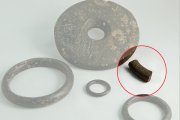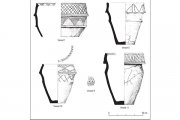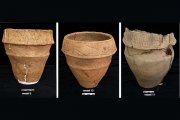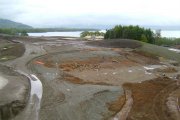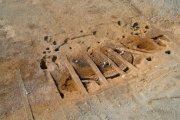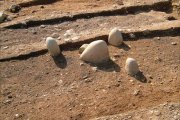Episode 3
Episode 3: Cremations and rituals
The next stage of the story of Mid Ross covers the period from around 4,500 to 2,800 years ago (2500 to 800 BC), commonly referred to as the Bronze Age. This spell of about 2,700 years is notable for very little evidence of how people lived here, but plenty of evidence for what happened to them after they died. It must be remembered, though, that the scarcity of remains relating to everyday domestic activities doesn’t mean that people weren’t living there – but the evidence may just not have been well-preserved or found. Notably, evidence from elsewhere suggests that people around this time were living more settled lives, sometimes in more substantial dwellings.
Between 4,000 and 3,500 years ago, the climate would have been a bit warmer than it is today, but then gradually cooled. Charcoal dated to this period suggested that the woodland included a similar range of trees and shrubs to those seen in the Neolithic period (oak, willow, alder, cherry, hazel etc.), while burnt cereal grains (oat, barley, wheat) indicated that the people living here continued to cultivate crops, though they probably also continued to hunt and fish.
Evidence for how people were living in the Bronze Age came from charcoal in pits and deposits, which included the above sorts of wood, as well as seeds from cereals, flax, a cabbage-like plant, peas, raspberries, and ‘fat hen’, and interestingly some seaweed. The pits also contained some bits of pottery and stone tools, and fire-cracked stones. A fragment of a shale bracelet (left) was found in one of these pits.
However, the main evidence of activity at Mid Ross during the Bronze Age related to how the living dealt with their dead. From around 3,950 to 3,520 years ago (according to radiocarbon dating), fragments of cremated human bone had been placed in pottery urns and buried in pits at three different locations. Each location included several pits, and one of the groups had been enclosed by a circular timber ‘fence’. Some of the urns were placed in the pits upright, others were upside down, and several of the urns were decorated with patterns (left).
Cremated bone, charcoal, and parts of stone tools or pots were also found around the urns, as well as in some pits that had no urns, while one pit also included fragments of burnt animal bone (maybe deer, goat/sheep). Does this suggest that there might have been feasting associated with the cremation? Where it was possible to estimate the age of the cremated person, some were children, others were estimated to be ‘at least 13’, between 15 and 23, or adolescents, i.e. all were very young by today’s standards. Interestingly, the bones of one child showed that they had suffered from anaemia, possibly due to an infection or to poor nutrition.
Prior to burial, an individual would have been cremated on a pyre, and their remains then collected up and placed in a pit or urn. The bones probably wouldn’t have turned completely to ash, hence the finding of fragments of bones. No doubt when collecting the cremated bone from the pyre, some of the burnt wood from the pyre itself would also have been collected, while some bone may have been missed. It is possible that some of the pyre material itself was placed in the pits around the urns. This style of burial contrasts with that seen in the Neolithic period, where bodies weren’t cremated, and the bones (of at least some individuals) were placed in chambered tombs, like the one at Cameron Home Farm.
Excitingly, the later Bronze Age (3,500 to 2,800 years ago) was also notable for the discovery of the remains of a circular timber structure, about 11.5 metres in diameter, partly recessed into the base of a slope (left).
The building had an entrance to the south-east, possibly with a porch. Although none of the timbers were preserved, archaeologists could identify the circular trench that the posts would have stood in, and the abundance of oak charcoal suggested that the posts may have been mostly of oak. There were also post holes within the structure, including one possibly for a central roof support, while groups of smaller stake holes indicated that the building might have had internal partitions, and linear gullies might have held timbers to support a raised wooden floor. A large curved gully contained carbonized wood and seeds, including barley, fat hen and cleavers, as well as sherds of Early Neolithic pottery.
There were two particular features within this building. One was a group of five, water-rolled stones stones arranged in what is referred to as a ‘quincunx’ pattern (though one stone seemed to have been removed) (left). Burnt fragments of human bone (dated to 3,200 to 2,920 years ago), as well as charcoal and pottery, had been placed against the stone in the centre of the quincunx.
The other was a large pit (0.9 × 1.3 metres), partly lined with stones, including a fragment of a cup-marked stone. The pit contained charcoal, including cereal grains, but also pieces of burnt human bone, dated to 3,060 to 2,840 years ago. The pit had been partly filled in, but there was more burnt bone nearer the top of the pit. Finally, the pit had been topped with a thin layer of stones. Interestingly, this building had no signs of a hearth, suggesting that it probably hadn’t been used as a traditional house, and the way the stone setting and pit were placed in the building suggested that it might have been built for ceremonial or ritual purposes. Radiocarbon dates from the burnt timbers and cremated bone revealed a gap of about 150 years between building the structure and the cremation of the bones. The abundance and location of charcoal suggested that this building may have eventually burned down.
Although there’s little to suggest that people’s daily lives changed that much between the Neolithic and the Bronze Age – they hunted and gathered, grew a few crops, and lived in shelters that left few traces – the dramatic change in how they dealt with their dead, and the occurrence of more crafted items like urns and shale jewellery, might reflect major social and cultural changes.
Blog
Click on the link here to check out our Facebook page.
Events
Click here to find out about forthcoming events and how to get involved.
Timeline
Click here to see our timeline of events.
Location
Click here to find out where the Hidden Heritage Project is taking place.
Contact Us
Click here for our contact details.


